The Chazen has accessioned seven Vietnamese works on paper that will significantly grow and diversify the museum’s holdings of contemporary art of Southeast Asia.
“We have few Southeast Asian works on paper, and very little contemporary art from Vietnam,” said James Wehn, the Chazen’s Van Vleck Curator of Works on Paper, who, along with Chief Curator Katherine Alcauskas, consulted with donors Judith and John Day on the gifts. Judith Day operates Judith Hughes Day Vietnamese Contemporary Fine Art. She has worked with Vietnamese artists since 1992, when she co-founded a Hong Kong gallery exclusively exhibiting contemporary Vietnamese art before returning to New York as a private dealer in 1998. John Day, who earned a master’s degree in political science at UW–Madison in 1966, is a retired international banker and dedicated conservationist who’s helped Judy whenever useful.
Wehn said the Days wanted to help the Chazen diversify its holdings of work by Asian artists. “They hope their gift will resonate with current Vietnamese American and Vietnamese-born students, alumni, and faculty, as well as visitors like themselves, who have read about and studied Vietnam’s culture and history,” he said.
The art reflects and references the many cultures and traditions within Vietnamese society, Wehn said. “It’s important to remember that Vietnam is composed of dozens of different ethnic groups.”
The new artworks can be viewed online or by special appointment in the Chazen’s Chen Family Study Room for Works on Paper.
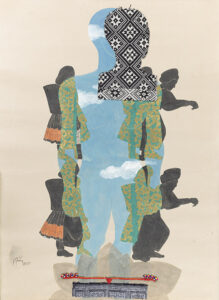
Dinh Thi Tham Poong (Vietnamese, b. 1970), Sky Weave, 2007, watercolor, gold paint, fabric collage on handmade dó paper, 41 3/4 x 22 in., gift of Judith Hughes Day and John G. Day, 2024.21.1
Dinh Thi Tham Poong ponders the complexities of identity in modern-day Vietnam by mixing cultural elements in her works, typically working on traditional handmade Vietnamese paper made from the bark of dó trees. Of Dai and Muong descent, Dinh Thi Tham Poong sometimes mixes cultural elements in her works, thereby alluding to the dozens of minority ethnic groups in Vietnam. Sky Weave exemplifies the process of layering watercolor, gold paint, and textile fragments on this thick paper to construct a symbolic body, the core of which, in this case, is a pale blue sky with clouds, symbolizing the subject’s balance with her environment. The sky-figure stands in the shadow of a lotus flower, a symbol of purity and enlightenment. Smaller silhouettes of women with wrapped heads, baskets, and embroidered skirts flank the central figure to further reflect her cultural heritage.
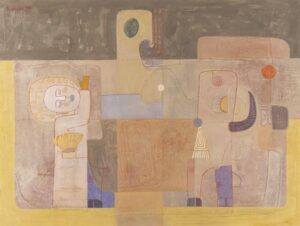
Trinh Quoc Chien (Vietnamese, b. 1966), Buffalo Boy’s Melody, 2010, acrylic, tempera, gouache, and metallic paint, with rice paper and crushed shell, on thick paper, 28 1/16 x 37 1/16 in., gift of Judith Hughes Day and John G. Day, 2024.21.5
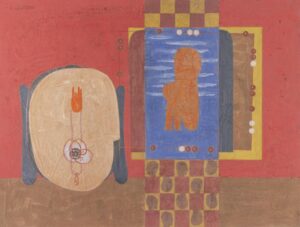
Trinh Quoc Chien (Vietnamese, b. 1966), Peace in the Soul, 2018, acrylic, tempera, gouache, and metallic paint, with rice paper, crushed shell, collage, and stamped images from wood “chops,” on thick paper, 28 1/2 x 37 7/16 in., gift of Judith Hughes Day and John G. Day, 2024.21.6
Trinh Quoc Chien, a leading contemporary lacquer artist, developed a unique method based on layering techniques used in traditional lacquer paintings. He uses modern acrylic, rice paper, tempera, and gouache (opaque watercolor) to produce textured paintings on thick paper. Applied to his highly symbolic paintings, this technique produces multi-dimensional images that draw deeply on Buddhist iconography and Vietnamese life. Dominated by a red ground, Peace in the Soul integrates several Buddhist signifiers: the head of the Buddha with elongated ear lobes, a mudra hand gesture and a lotus flower draped with prayer beads, and the silhouette of a seated, meditating figure.
Buffalo Boy’s Melody, with its muted color palette and composition veiling its subject matter, experiments with imagery from folklore and everyday life rather than overt Buddhist symbols. The subject may allude to youth who tend water buffalo in Vietnamese farming communities, and the reference to melody may relate to folk music there.
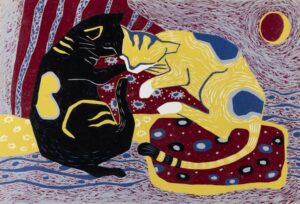
Trinh Ngoc Le (Vietnamese, b. 1997), Dream (Cats Red), 2018, color woodcut, 15 5/16 x 22 1/2 in., gift of Judith Hughes Day and John G. Day, 2024.21.7
Trinh Ngoc Le is an artist and printmaker and the daughter of lacquer artist Trinh Quoc Chien (see above). Dreams (Cats Red) is one of two color variations Trinh Ngoc Le printed in limited editions from the same woodblocks. Cats are favored pets in Vietnam, where the cat replaces the rabbit in the Vietnamese version of the Chinese zodiac. This is the Chazen’s first print by a Vietnamese artist, and it will further diversify the Chazen’s rich holdings of color woodcuts by artists from around the world.
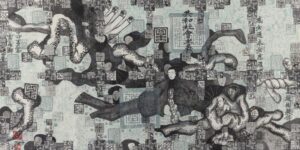
Le Quoc Viet (Vietnamese, b. 1972), Portraits and Calligraphy , 2004, ink drawing and calligraphy with woodcut seals on handmade paper, 25 3/4 x 51 7/16 in., gift of Judith Hughes Day and John G. Day, 2024.21.2
Le Quoc Viet is an artist, calligrapher, and printmaker who uses age-old techniques and materials to probe Vietnam’s complicated past and to critique modern society. The work often sits at the axis of language and Buddhist principles. Portraits and Calligraphy includes painting, calligraphy, and print: entangled abstract forms and figural representations float in a sea of ink script and woodcut seals (“chops”).
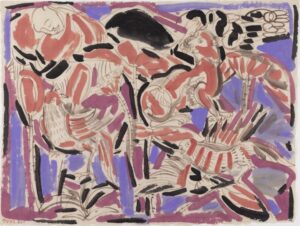
Phan Cam Thuong (Vietnamese, b. 1957), Buddha’s Garden II , 2009, ink and natural mineral color on handmade paper, 23 5/16 x 31 1/16 in., gift of Judith Hughes Day and John G. Day, 2024.21.4
Phan Cam Thuong‘s work draws on his interest in calligraphy and Buddhist scholarship. He typically prepares his own pigments from ground minerals or other materials, like bamboo ash for his ink. An exceptional demonstration of his artistic practice, Buddha’s Garden II integrates ink and mineral-based colors with bold brushwork. Energized by vibrant salmon, pink, and purple colors, the scene depicts a Buddhist monk sleeping in a garden filled with lotus flowers and pods, birds, and a small lion.
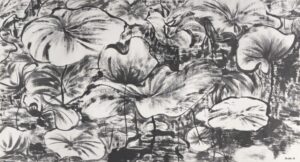
Nguyen Bach Dan (Vietnamese, 1970–2012), Lotuses , 2010, ink on paper, 37 7/8 x 70 1/4 in., gift of Judith Hughes Day and John G. Day, 2024.21.3
Nguyen Bach Dan is among Vietnam’s most important contemporary artists who have carried on the longstanding tradition of ink painting. Painted on the largest format paper she used, Lotuses demonstrates the artist’s adept use of wet and dry brushes of different sizes to articulate line, shape, texture, light and shadow. This monumental depiction of a flourishing lotus pond speaks to the plant’s Buddhist meaning as an emblem of transformation and purity. In Vietnam, the lotus is also representative of femininity. As part of the Chazen’s collection, this painting will compare with a range of ink historical and contemporary landscapes, including Xu Bing’s Ten Thousand Trees.